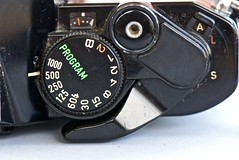Canon AE-1 Program
| Canon AE-1 Program |
|---|
|
Manufacturer: Canon
Film type: 35mm
|
| ||
| ||
The AE-1 Program is a 35mm SLR camera made by Canon in 1981. Canon describes it as a successor to the enormously successful AE-1, released five years earlier.[1] though in some ways it is also accurate to call it a budget version of the more upmarket A-1. Many users wanted an entry-level SLR with the 'Program' (auto exposure) mode found on the A-1, whereas the earlier AE-1 has only shutter-priority AE (and metered-manual exposure). For this reason, when designing its successor, Canon added a program AE mode to the specification, and the AE-1 Program became even more popular than the AE-1.
Program mode on this camera is considered fairly intelligent for the period, as it prefers moderate apertures in good light with normal film speeds (preferring f/5.6 and f/8 when possible) but gives workable solutions in all kinds of light conditions. The meter is activated by one of three buttons; the lower of the two buttons on the lens mount (placed for the photographer's left hand) activates it normally, as does depressing the shutter-release halfway, while the upper button on the lens mount both activates the meter and locks the current reading for as long as the button is held down.
When the meter is on, the aperture being selected is lit up by LED's to the right of the viewfinder. A "M" appears when the aperture ring is not at the "A" position (for automatic aperture selection), but the recommended aperture will still be correct; it is possible to benefit from the meter while shooting manually. A green "P" will appear if the shutter dial is set to "Program," indicating programmed auto-exposure is active. The aperture number will flash if the aperture being selected is out of the range of the lens, and the "P" will flash if program mode is selecting a speed below 1/60th of a second, to indicate that a tripod should be used.
With certain flashes, the camera has partial automation. If a compatible flash is connected and the camera is set to 1/60th, the camera will display a lightning bolt in the viewfinder when the flash is ready to fire, and the aperture selected on the flash is communicated to the camera automatically. (At the time, this normally involved setting the range to subject on the back of the flash.)
Canon also upgraded the available power winder (winder A2 replacing the A1, although the A1 is forwards-compatible), and the camera can also be used with Motor Drive MA.[1] The camera also has the A-1's 'Action Grip', the detachable (and so frequently lost) grip on the front right of the body, which lets the user more securely and comfortably hold the camera one-handed (with the right hand only.) The camera looks very similar to the original AE-1, but is internally quite different.[2]
The A-series SLRs were built using some plastic parts (including metallised plastics for top and bottom covers, not always recognised as plastic) to a varying extent (the A-1 has less plastics than the AE-1P, including metal top and bottom covers; the AV-1 has more). This has sometimes been criticised as simple cost-cutting, but probably contributed as much to reducing the weight of the cameras, in a period when several Japanese makers were already doing this (as in, for example, the Pentax ME and Olympus OM-1).
Like all the A-series cameras, the Program can develop a 'squealing' fault of the mirror brake. This can be remedied by re-lubricating the mechanism. Failure to correct the fault can eventually lead to irreparable damage. Like the A-1 and AE-1, the Program's battery compartment door (a plastic part, even on the A-1) fails rather easily, though this is compensate for by the action grip, which both protects the door and covers it if it fails, making the breakage less visible and problematic.[3]
Notes
- ↑ 1.0 1.1 AE-1 Program at the Canon Camera Museum,
- ↑ Tomosy, Thomas (1999) Camera Maintenance and Repair, Book 1, revised edition, 1999. Amherst Media Inc., Buffalo NY. ISBN0-936262-86-9. p97, primarily about the AE-1.
- ↑ As at January 2016, a replacement battery door for the AE-1 (which may fit other models) is offered by micro-tools.de.
Links
- Modern Classics Review
- Canon AE-1 Program Camera Manual (PDF) : Photo-Manuals.com
- The A Team an article about the SLR A models, AE-1, AT-1, A-1, AV-1 and AE-1 Program at Classic Cameras by RaúlM.
- Lionel's Canon AE-1 Program overview at 35mm-compact.com (in French)
- AE-1 Program at www.collection-appareils.fr (in French)


